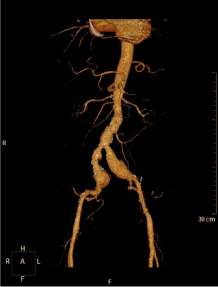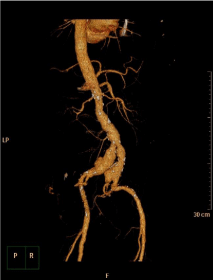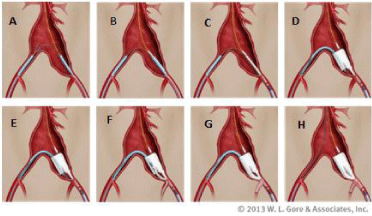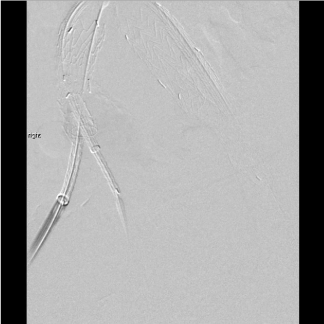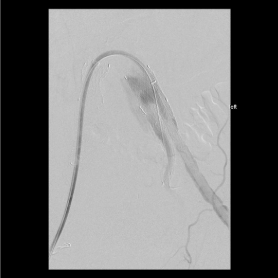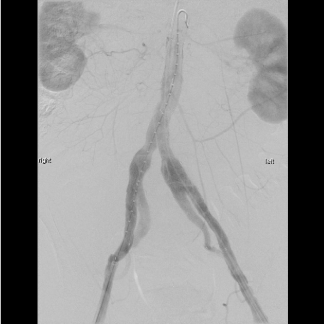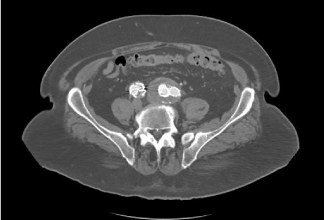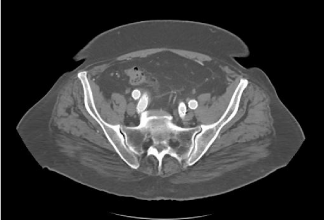Case Report
Treatment of Bilateral Iliac Aneurysms with Gore Iliac Branch Endoprostheses: Case Report and Review of the Literature
Sruthi Muluk1* and Naval Udgiri2
1Harvard College, USA
2Department of Vascular Surgery, St. Vincent Regional Health System, USA
*Corresponding author: Sruthi Muluk, Harvard College, 294 Dunster Mail CTR, 945 Memorial Drive Cambridge, MA 02138-7544, USA
Published: 28 Nov, 2016
Cite this article as: Muluk S, Udgiri N. Treatment of
Bilateral Iliac Aneurysms with Gore Iliac
Branch Endoprostheses: Case Report
and Review of the Literature. Clin Surg.
2016; 1: 1179.
Abstract
Introduction: Bilateral common iliac aneurysms that extend to the distal portion cannot be readily treated with standard endografts. A common strategy for unilateral iliac aneurysms is to embolize
and cover the internal iliac on the side of the aneurysm, but this strategy is associated with significant
side effects. The coil/cover approach is particularly undesirable for bilateral iliac aneurysms. The
recent introduction of the Gore Iliac Branch Endoprosthesis (IBE) facilitates preservation of flow to
the internal iliac. In this paper, we describe the first reported case of using two IBE devices to treat a
patient with bilateral iliac aneurysms.
Case Presentation: A 75-year old male presented with asymptomatic bilateral common iliac
aneurysms. He was treated with bilateral Gore Excluder® Iliac Branch Endoprostheses. The patient
tolerated the procedure well and follow-up imaging showed no endoleak and patency of all relevant
arteries.
Discussion: Bilateral common iliac aneurysms which extend to the distal iliac pose a problem because
the traditional coil/cover strategy can lead to symptoms such as sexual dysfunction and buttock
claudication. There are several other methods of treating this subset of aneurysms, including iliac
branch devices (IBDs). The early literature on the use of IBDs is promising. This case presentation
demonstrates that bilateral IBDs can be successfully used in patients with suitable anatomy.
Keywords: Bilateral iliac aneurysms; Endoprostheses; Chronic warfarin therapy; Iliac aneurysms (IA)
Introduction
Bilateral common iliac aneurysms that extend to the distal portion cannot be readily treated with standard endografts. A common strategy for unilateral iliac aneurysms is to embolize and cover the internal iliac on the side of the aneurysm, but this strategy is associated with significant side effects. The coil/cover approach is particularly undesirable for bilateral iliac aneurysms. The recent introduction of the Gore Iliac Branch Endoprosthesis (IBE) facilitates preservation of flow to the internal iliac. In this paper, we describe the first reported case of using two IBE devices to treat a patient with bilateral iliac aneurysms.
Case Presentation
A 75-year-old male presented with asymptomatic bilateral common iliac aneurysms, which
were discovered incidentally during workup for bladder infection. The patient had a history of
obesity, stroke, myocardial infarction, and severe congestive heart failure. He had an automatic
internal cardiac defibrillator (AICD) placement and was on chronic warfarin therapy. On exam, his
abdomen was obese. His iliac aneurysms were not palpable. He had strong femoral pulses, and his
lower extremities were well perfused. His CT angiogram demonstrated a small aortic aneurysm, a
4.2 cm left common iliac aneurysm (CIA), and a 2.3 cm right CIA which extended into the internal
iliac (Figure 1A and 1B). The internal iliac aneurysm measured 3.1 cm. The patient was deemed
to be too high risk for open repair. Rather than sacrifice either internal iliac, we proceeded with
bilateral iliac branch endograft repair using two Gore Excluder® Iliac Branch Endoprostheses (IBE).
The Gore IBE is indicated to be used in conjunction with the Gore Excluder aortic device. The
IBE is designed to mate with the aortic device to achieve full exclusion of both the aortic and iliac aneurysmal components.
Bilateral percutaneous femoral access was achieved. The Gore
IBE has a two-wire system, one for the center channel and another
which was pre-cannulated through the iliac branch gate. Both wires
were passed through the left femoral artery into the common iliac,
using a 16-FrenchGore Dryseal® sheath. The pre-cannulated wire
was snared from the right groin, following which the IBE device was
passed into the left common iliac (Figure 2A, 2B and 2C). The IBE
was partially deployed to expose its main body and the internal iliac
gate (Figure 2D). Following this, with the crossing wire held under
tension, a 12-French sheath was passed from the right side into the
internal iliac gate (Figure 2D and 2E). The left internal iliac was then
cannulated and the internal iliac stent-graft deployed (Figure 2F and
2G). The crossing 12-French sheath was then removed (Figure 2H).
The mirror-image process was carried out on the right side, taking
care to ensure a seal beyond the right internal iliac aneurysm. At this
time, we noted that the left internal iliac stent-graft had migrated
distally (Figure 3A), reducing the seal zone in the gate. For this
reason, we re-accessed the left IBE from the right and placed a second
internal iliac stent-graft (Figure 3B). Once the IBEs were in place, a
standard Gore aortic endograft was deployed just below the left renal
artery (the lower of the two). Right and left bridge pieces connecting
the aortic endograft to the IBEs were then deployed. An angiogram
demonstrated a successful outcome, with wide patency of both renal
arteries and both internal iliacs, with no endoleak (Figure 4). The
patient tolerated the procedure well. Follow-up imaging showed that
the grafts were patent with no endoleak present (Figure 5A and 5B).
Figure 1A
Figure 1B
Figure 1B
Rotated 3-D reconstruction showing extension of the right common iliac aneurysm into the internal iliac.
Figure 2
Figure 3A
Figure 3A
Fluoroscopic image showing the gap between the left internal iliac stent-graft and the IBE gate.
Figure 3B
Figure 3B
Fluoroscopic image depicting repeat cannulation of left internal iliac prior to deployment of the second stent-graft.
Figure 4
Figure 4
Completion angiogram demonstrating patency of both renal arteries and both internal iliacs.
Figure 5A
Figure 5A
One-month follow-up axial CTA image showing the common iliac arteries. No endoleak is observed.
Figure 5B
Figure 5B
One-month follow-up axial CTA image showing patent right and
left external and internal iliac stent-grafts.
Discussion
Iliac aneurysms (IA), either bilateral or unilateral, appear along
with abdominal aortic aneurysms (AAA) in 20-30% of patients [1]. In
cases where the aneurysm reaches the distal portion of the common
iliac, a traditional stent-graft is not an option as there is no location
for adequate seal within the common iliac.
One solution to this problem is to extend the graft into the
external iliac artery. This requires embolization of the internal iliac
to prevent Type II endoleak, and it effectively cuts off blood flow to
the internal iliac artery. Blocking the internal iliac can have adverse
effects such as buttock claudication and sexual dysfunction. Sexual
dysfunction can affect 15-60% of patients with unilateral internal
iliac coverage and 80% of patients with bilateral coverage [2]. Buttock
claudication was found to occur in 28-38% of patients on the side of
embolization [3,4]. Many surgeons have adopted the approach that
the embolization/cover strategy is acceptable if it can be limited to
one side. However, even unilateral internal iliac coverage is not free
of morbidity.
Another option is open surgery. Quite often, however, patients,
such as the one discussed in this case report, have substantial
comorbidities which make open surgery too risky. The other option is
to perform an endovascular procedure that includes revascularization
of the internal iliac. There are a few options when it comes to such
revascularization. First, a surgical bypass that connects the external
iliac to the internal iliac can be performed prior to the graft placement.
This can be a difficult operation and is only rarely used. A second
option is the “sandwich technique,” [5] in which side-by-side grafts
are placed into the external and internal iliac arteries. This method
generally requires arm access for placement of the internal iliac graft,
although contralateral femoral access may suffice for certain aortic
endografts such as the AFX graft made by Endologix. Moreover, the
sandwich technique can be problematic because of gutter leak. A final
option, discussed in this case report, is a branched iliac graft, whether
“home-made” or commercial. This option preserves internal iliac flow
without requiring arm access or risk of gutter leak. However, homemade
grafts are off-label and difficult to construct, while commercial
iliac branched devices (IBDs) can be expensive, especially for bilateral
CIAs.
IBD configurations have been classified as straight, helical, or
bifurcated-bifurcated [6]. Multiple studies have found that currentgeneration
IBDs can be implanted with success rates ranging from
75-100% [1,7-12]. It is apparent that results have improved over time
with better device design [1,13,14]. Early published results using
the Gore IBE, which was only recently approved by the FDA, have
demonstrated excellent outcomes among carefully selected patients,
with technical success of 93-95% and low morbidity [4,12].
However, there is still room for improvement in device design.
According to Gray et al. [15], more than 40% of iliac aneurysms
would not be amenable to therapy with the Cook Zenith Iliac Side
Branch Stent Graft. Pearce et al. [16] found that only 35% of common
iliac aneurysms would be eligible for Cook and Gore devices, based
on their “Instructions for Use”. The major reason for exclusion was
the internal iliac landing zone. IBD design must be enhanced to allow
for shorter and more diseased landing zones.
Branch devices can be used for unilateral or bilateral iliac
aneurysms. The few studies which investigated bilateral iliac
aneurysms revealed that the IBDs can be effective in this condition
[11,17-19]. One study mentioned the need to place a graft in a healthy
aorta in order to support the IBD. The authors expressed hope that
new IBDs would be developed which would be able to stand on their
own in the iliac artery [20].
Conclusion
To our knowledge, no study has previously reported the use of bilateral Gore Excluder® IBE devices. The current case report demonstrates that in patients with suitable anatomy, bilateral IBEs can be deployed with good technical and clinical success. More study and literature will help to further reinforce this conclusion.
References
- Malina M, Dirven M, Sonesson B, Resch T, Dias N, Ivancev K. Feasibility of a branched stent-graft in common iliac artery aneurysms. J Endovasc Ther. 2006; 13: 496-500.
- GGhosh J, Murray D, Paravastu S, Farquharson F, Walker MG, Serracino- Inglott F. Contemporary Management of Aorto-iliac Aneurysms in the Endovascular Era. Euro J Vasc Endovasc Surg. 2009; 37: 182-188./a>
- Taudorf M, Gronvall J, Schroeder TV, Lonn L. Endovascular Aneurysm Repair Treatment of Aortoiliac Aneurysms: Can Iliac Branched Devices Prevent Gluteal Claudication? J Vasc Interv Radiol. 2016; 27: 174-180.
- Schneider DB, Matsumura J, Oderich GS, Lee JT, Peterson BG. SS27. Pivotal Results for the Gore Excluder Iliac Branch Endoprosthesis for Treatment of Aortoiliac Aneurysms in the IBE 12-04 Prospective, Multicenter Study. J Vasc Surg. 2016; 63: 226S-227S.
- Lobato AC, Camacho-Lobato L. The sandwich technique to treat complex aortoiliac or isolated iliac aneurysms: results of midterm follow-up. J Vasc Surg. 2013; 57: 26S-34S.
- Oderich GS, Greenberg RK. Endovascular iliac branch devices for iliac aneurysms. Perspect Vasc Surg Endovasc Ther. 2011; 23: 166-172.
- Karthikesalingam A, Parmar J, Cousins C, Hayes PD, Varty K, Boyle JR. Midterm results from internal iliac artery branched endovascular stent grafts. Vasc Endovascular Surg. 2010; 44: 179-183.
- Haulon S, Greenberg RK, Pfaff K, Francis C, Koussa M, West K. Branched grafting for aortoiliac aneurysms. Eur J Vasc Endovasc Surg. 2007; 33: 567- 574.
- Greenberg RK, West K, Pfaff K, Foster J, Skender D, Haulon S, et al. Beyond the aortic bifurcation: branched endovascular grafts for thoracoabdominal and aortoiliac aneurysms. J Vasc Surg. 2006; 43: 879-886.
- Parlani G, Verzini F, De Rango P, Brambilla D, Coscarella C, Ferrer C, et al. Long-term results of iliac aneurysm repair with iliac branched endograft: a 5-year experience on 100 consecutive cases. Eur J Vasc Endovasc Surg. 2012; 43: 287-292.
- Loth AG, Rouhani G, Gafoor SA, Sievert H, Stelter WJ. Treatment of iliac artery bifurcation aneurysms with the second-generation straight iliac bifurcated device. J Vasc Surg. 2015; 62: 1168-1175.
- Schonhofer S, Mansour R, Ghotbi R. Initial results of the management of aortoiliac aneurysms with GORE(R) Excluder(R) Iliac Branched Endoprosthesis. J cardiovasc surg. 2015; 56: 883-888.
- Karthikesalingam A, Hinchliffe RJ, Holt PJ, Boyle JR, Loftus IM, Thompson MM. Endovascular aneurysm repair with preservation of the internal iliac artery using the iliac branch graft device. Eur J Vasc Endovasc Surg. 2010; 39: 285-294.
- Paraskevas KI, Mollendorf C, Fernandes E, Fernandes R, Tielliu IF, Verhoeven EL. EVAR for aortoiliac aneurysms, including iliac branched grafts. J cardiovasc surg. 2012; 53: 67-72.
- Gray D, Shahverdyan R, Jakobs C, Brunkwall J, Gawenda M. Endovascular aneurysm repair of aortoiliac aneurysms with an iliac side-branched stent graft: studying the morphological applicability of the Cook device. Eur J Vasc Endovasc Surg. 2015; 49: 283-288.
- Pearce BJ, Varu VN, Glocker R, Novak Z, Jordan WD, Lee JT. Anatomic suitability of aortoiliac aneurysms for next generation branched systems. Ann Vasc Surg. 2015; 29: 69-75.
- Ferreira M, Monteiro M, Lanziotti L. Technical aspects and midterm patency of iliac branched devices. J Vasc Surg. 2010; 51: 545-550.
- Kim JT, Jeon YS, Lim HK, Kim YS, Yoon YH, Baek WK. Endovascular Treatment of Isolated Bilateral Common Iliac Artery Aneurysms Using Iliac Branched Stent Graft. Vasc Specialist Int. 2014; 30: 87-90.
- You JH, Park HK, Park CB. Endovascular repair of bilateral iliac artery aneurysm with branched iliac stents: case report and review of the current literature. J Korean Surg Soc. 2013; 85: 145-148.
- Kassaian SE, Abbasi K, Al-Sibaie AA. Endovascular treatment of isolated bilateral internal iliac artery aneurysms with a branched endograft: a case report. J Tehran Heart Cent. 2013; 8: 116-118.

